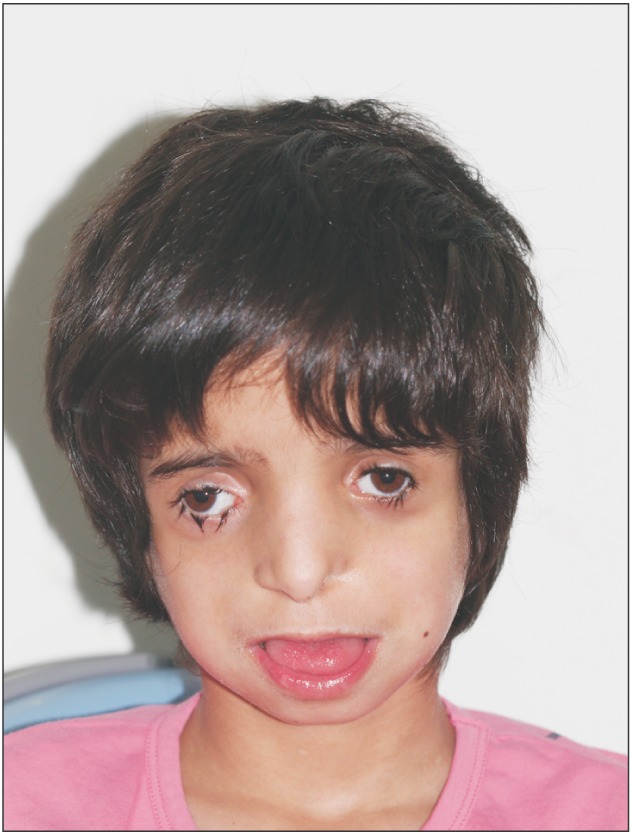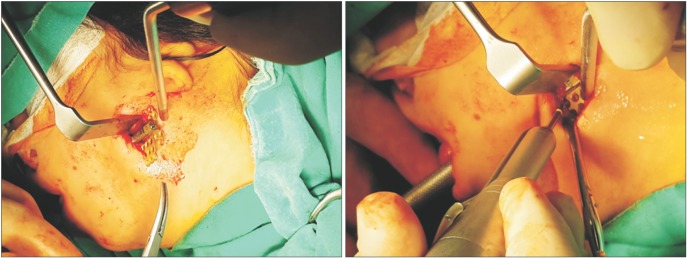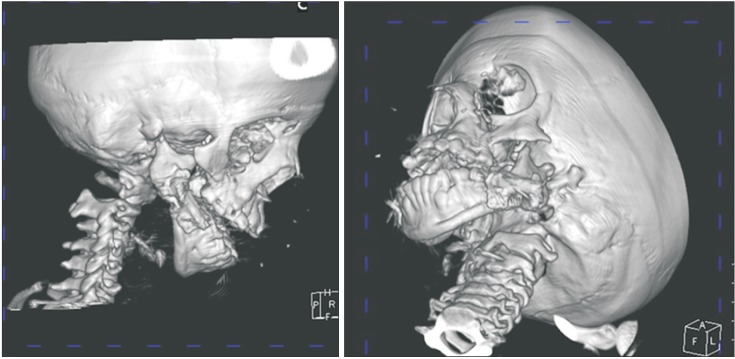J Korean Assoc Oral Maxillofac Surg.
2016 Dec;42(6):388-392. 10.5125/jkaoms.2016.42.6.388.
Management of obstructive sleep apnea in a Treacher Collins syndrome patient using distraction osteogenesis of the mandible
- Affiliations
-
- 1Private Practice, Faculty of Dentistry, GaziosmanpaÅŸa University, Tokat, Turkey.
- 2Department of Oral and Maxillofacial Surgery, Faculty of Dentistry, GaziosmanpaÅŸa University, Tokat, Turkey. dt.ahmetaltan@gmail.com
- 3Department of Oral and Maxillofacial Surgery, Faculty of Dentistry, Mustafa Kemal University, Hatay, Turkey.
- KMID: 2364009
- DOI: http://doi.org/10.5125/jkaoms.2016.42.6.388
Abstract
- In this study, we present the surgical treatment of obstructive sleep apnea in a child with Treacher Collins syndrome. A 10-year-old girl with a past history of Treacher Collins syndrome presented to our clinic with her parents for respiratory distress and insomnia. The patient was referred to a sleep laboratory where she was diagnosed with obstructive sleep apnea, which was a consequence of her Treacher Collins syndrome. The patient underwent mandibular distraction osteogenesis under general anesthesia. The mandible was expanded by 15 mm using internal bilateral distractors. After distraction osteogenesis, the patient's respiratory problems resolved, and she was able to sleep comfortably. Distraction osteogenesis was an effective method of advancing the mandible, increasing the upper airway space and ultimately preventing obstructive sleep apnea syndrome in patients with Treacher Collins syndrome.
Keyword
MeSH Terms
Figure
Reference
-
1. Akre H, Øverland B, Åsten P, Skogedal N, Heimdal K. Obstructive sleep apnea in Treacher Collins syndrome. Eur Arch Otorhinolaryngol. 2012; 269:331–337. PMID: 21626120.
Article2. Jin SM, Lee HS, Ryu HH, Ryu SH, Shin DY, Kim CH, et al. Retrospective study on the airway obstruction aspects of computed tomography and lateral cephalometry and the correlation of polysomnography in obstructive sleep apnea patients. J Korean Assoc Oral Maxillofac Surg. 2012; 38:295–304.
Article3. Okşayan R, Sökücü O, Uyar M, Topçuoğlu T. Effects of edentulism in obstructive sleep apnea syndrome. Niger J Clin Pract. 2015; 18:502–505. PMID: 25966722.
Article4. Hoeve LJ, Pijpers M, Joosten KF. OSAS in craniofacial syndromes: an unsolved problem. Int J Pediatr Otorhinolaryngol. 2003; 67(Suppl 1):S111–S113. PMID: 14662180.
Article5. Rosen CL, Storfer-Isser A, Taylor HG, Kirchner HL, Emancipator JL, Redline S. Increased behavioral morbidity in school-aged children with sleep-disordered breathing. Pediatrics. 2004; 114:1640–1648. PMID: 15574628.
Article6. Hoeve HL, Joosten KF, van den Berg S. Management of obstructive sleep apnea syndrome in children with craniofacial malformation. Int J Pediatr Otorhinolaryngol. 1999; 49(Suppl 1):S59–S61. PMID: 10577777.
Article7. Østertun Geirdal A, Øverland B, Heimdal K, Storhaug K, Asten P, Akre H. Association between obstructive sleep apnea and health-related quality of life in individuals affected with Treacher Collins syndrome. Eur Arch Otorhinolaryngol. 2013; 270:2879–2884. PMID: 23455582.
Article8. Posnick JC, Ruiz RL. Treacher Collins syndrome: current evaluation, treatment, and future directions. Cleft Palate Craniofac J. 2000; 37:434. PMID: 11034023.
Article9. Plomp RG, Bredero-Boelhouwer HH, Joosten KF, Wolvius EB, Hoeve HL, Poublon RM, et al. Obstructive sleep apnoea in Treacher Collins syndrome: prevalence, severity and cause. Int J Oral Maxillofac Surg. 2012; 41:696–701. PMID: 22521672.
Article10. Rachmiel A, Emodi O, Rachmiel D, Aizenbud D. Internal mandibular distraction to relieve airway obstruction in children with severe micrognathia. Int J Oral Maxillofac Surg. 2014; 43:1176–1181. PMID: 25052572.
Article11. Mohan RP, Verma S, Agarwal N, Singh U. Treacher Collins syndrome: a case report. BMJ Case Rep. 2013; DOI: 10.1136/bcr-2013-009341.
Article12. Posnick JC. Treacher Collins syndrome: perspectives in evaluation and treatment. J Oral Maxillofac Surg. 1997; 55:1120–1133. PMID: 9331237.
Article13. Rachmiel A, Emodi O, Aizenbud D. Management of obstructive sleep apnea in pediatric craniofacial anomalies. Ann Maxillofac Surg. 2012; 2:111–115. PMID: 23483041.
Article14. Morovic CG, Monasterio L. Distraction osteogenesis for obstructive apneas in patients with congenital craniofacial malformations. Plast Reconstr Surg. 2000; 105:2324–2330. PMID: 10845284.
Article15. Wolford LM, Perez DE. Surgical management of congenital deformities with temporomandibular joint malformation. Oral Maxillofac Surg Clin North Am. 2015; 27:137–154. PMID: 25483449.
Article
- Full Text Links
- Actions
-
Cited
- CITED
-
- Close
- Share
- Similar articles
-
- Bilateral Rapid Distraction of Mandible
- Fiberoptic Bronchoscopic Intubation in a Patient with Treacher-Collins Syndrome
- Airway Management in the Patients of Expected Difficult Intubation: A Case Report
- The Role of Endothelin-1 in Obstructive Sleep Apnea Syndrome and Pulmonary Hypertension
- A Sleepy Man with Chronic Obstructive Pulmonary Disease-Obstructive Sleep Apnea Overlap Syndrome







